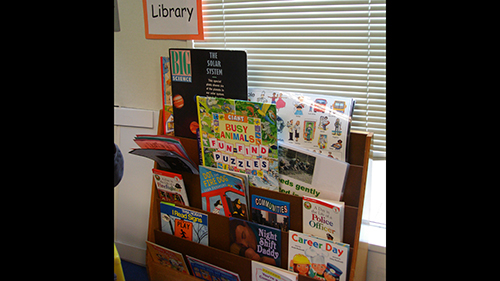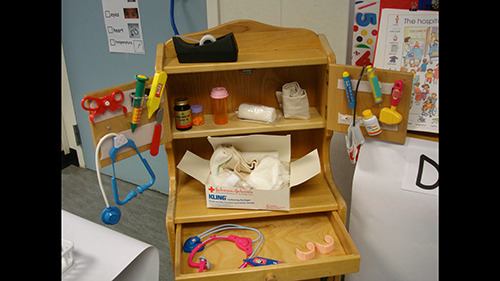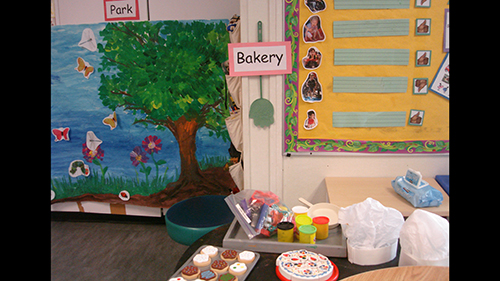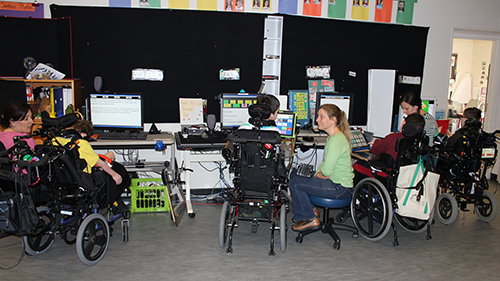At The Bridge School, AAC interventions focus on participation within the natural environment of the school. AAC interventionists provide services within the classroom environment, working alongside the special educator and related service providers. Specific student skills are targeted in the context of on-going instruction with the natural partners in that student’s typical school day (e.g., instructional assistants, classmates, teachers, etc.). In this way, authentic participation and real-life interactions can be supported.
Learning environments can impact communication for learners with different communicator profiles.
EMERGENT COMMUNICATORS
Emergent communicators use facial expressions, body language, gestures, vocalizations, and other non-symbolic modes of communication, which may be idiosyncratic and not immediately apparent to unfamiliar partners. At this level, any use of intelligible speech, symbols, or signs is limited and often used inappropriately.
These individuals communicate primarily about the “here and now,” unless with a highly familiar partner who has shared experiences or is able to guess their intent. Interventions for emerging communicators focus on establishing more reliable communication behaviors, moving towards symbolic expression, and increasing opportunities for interactions with more partners about a broader range of topics.
Familiar, predictable environments and partners work to support and enhance the development of communicative competence skills for emergent communicators. Physical characteristics of the environment, such as the location of objects, seating arrangements and the location of communication tools within a classroom, can enhance or detract from a students’ development of new skills. For example, the way classroom materials are displayed can entice students to initiate interactions and express their preferences.
At The Bridge School, classroom learning and play centers and activity spaces are clearly defined and do not change on a daily basis. Students have a regular desk/computer station for independent work. Communication tools are situated in consistent locations to promote regular use. They are placed within play-based centers and/or displayed on classroom walls and tables within easy reach. Bridge staff members introduce new materials and technologies as well as unfamiliar partners gradually to give emergent communicators time to adjust to changes in the environment. Also, they adjust learner demands and expectations in new, unfamiliar environments (e.g., field trips).
CONTEXT-DEPENDENT COMMUNICATORS
Context-dependent communicators use reliable symbolic communication modes, but communication may still be limited to certain partners, topics, or contexts. These limitations may occur because the individual’s speech is unintelligible or because the communication strategies they use are so unique that interactions must be facilitated by a familiar partner.
Context-dependent communicators may lack experience with appropriate AAC interventions, lack access to sufficient vocabulary, or lack conventional literacy skills. These factors means the individual is dependent upon others to select and program words and messages for them. Interventions for context-dependent communicators focus on increasing access to vocabulary, building literacy skills, and broadening the person’s ability to communicate with multiple of communication partners and across contexts. Additionally, intervention can focus on integrating all available communication modes into a repertoire of effective communication strategies.
The context-dependent communicator often depends on familiar partners and environmental factors to help them communicate effectively. At The Bridge School, care is taken to create consistent, clearly-defined learning environments to support context-dependent communicators as they work to build their communication skills. Staff members make an effort to provide access to large vocabularies and to develop each student’s literacy skills so they can use technologies that enable them to talk about whatever they want, whenever they want. In addition, staff place classroom materials and learning centers in predictable locations for students so they can use them while communicating (e.g., signaling towards the lunchbox bin to indicate a request to have a snack). Many of these students are unable to access sufficient vocabulary across a wide range of environments so familiar partners often supply important shared background knowledge to enhance interactions.
INDEPENDENT COMMUNICATORS
Independent communicators interact with familiar and unfamiliar partners, about any topic or context. Independent communicators are literate and able to generate completely novel messages, rather than rely on pre-programmed messages. They may be adept at using a variety of communication modes and strategies appropriately in different contexts and with different partners.
Intervention goals for independent communicators focus on rate enhancement strategies, gaining more operational competencies and refining access to new technologies and communication formats (email, social media, etc.).
Environmental considerations for independent communicators include broadening the number of environments students encounter across the school day, engineering environments for physical access to activities and materials and working with the student to select preferred AAC and AT tools and strategies for different environments and activities.

The preschool classroom centers are clearly defined, infused with communication tools and contain props for pretend play for the ‘Community Helper’ theme.

Different locations in the ‘community’ are arranged within the classroom space for easy access for students in wheelchairs and assisted mobility devices.

Library

Doctor’s Office

Bakery and the Park

The Bakery

Students have individual workstations where materials are consistently located.
References
Beukelman, D. and Mirenda, P. (2013). Augmentative and Alternative Communication: Supporting children & adults with complex communication needs. Fourth Ed. Baltimore: Paul H. Brookes Publishing Co.
Blackstone, Sarah W. & Hunt-Berg, M. (2012). Social Networks: A Communication Inventory for Individuals with Complex Communication Needs and their Communication Partners.
Collier, B., McGhie-Richmond, D., & Self, H. (2010). Exploring communication assistants as an option for increasing communication access to communities for people who use augmentative communication. Augmentative and Alternative Communication, 26, 48-59.
Kent-Walsh, J., Binger, C., & Hasham, Z. (2010). Effects of Parent Instruction on the Symbolic Communication of Children Using Augmentative and Alternative Communication During Storybook Reading. American Journal of Speech-Language Pathology, Vol. 19, 97-107.
Light, J. & McNaughton, D. (2014). Communicative Competence for individuals who require augmentative and alternative communication: A new definition for a new era of communication? Augmentative and Alternative Communication, 30:1, p1-18.

